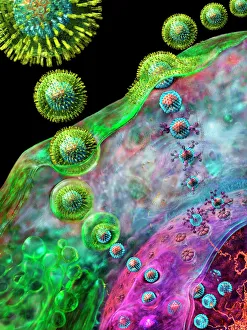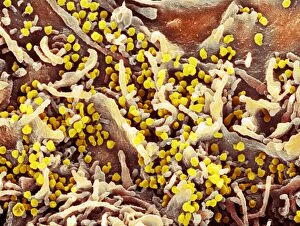Hsv 1 Collection
"Hsv 1: Unveiling the Intricate World of Herpes Virus Replicating" In this captivating computer artwork, we delve into the microscopic realm of herpes virus particles
All Professionally Made to Order for Quick Shipping
"Hsv 1: Unveiling the Intricate World of Herpes Virus Replicating" In this captivating computer artwork, we delve into the microscopic realm of herpes virus particles. The intricate design showcases the mesmerizing complexity of these minuscule entities as they replicate within a host cell. One striking image displays a cluster of herpesvirus particles, their distinct shapes and sizes forming an awe-inspiring spectacle. Another artwork zooms in on a single herpes virus particle, revealing its detailed structure and composition. Amidst this visual exploration, we encounter Herpesvirus immune inhibitor protein F006/9476 – an essential player in evading our body's defense mechanisms. Its strategic role becomes apparent as it manipulates our immune system to facilitate viral replication. Further magnification brings us face-to-face with cells infected by the relentless herpes virus. Scanning electron microscopy captures their altered appearance, showcasing the profound impact of viral invasion. Each image - C014/0604, C014/0602, C014/0600, C014/0603 and C014/0601 - portrays unique perspectives on how this insidious virus alters cellular structures. Finally, through transmission electron microscopy (TEM), we witness the true essence of herpes simplex virus particles at an even greater level of detail. These images provide invaluable insights into their morphology and shed light on their ability to cause infection. As we navigate through these captivating visuals depicting hsv 1's world within ours, let us marvel at both its intricacy and resilience while striving for better understanding and potential breakthroughs in combating this pervasive viral foe.








